So Marvel has been making business headlines all day with the news that the boards of Marvel Entertainment and Disney have agreed to the latter acquiring the former for around $4 billion in cash and stocks. Marvel's stock shot up 26% on the news.
What will this mean for Marvel? For the comics, probably not much -- except that Disney may use its new comic-book arm to publish comics of its characters. The main benefit will likely be for media exploitation of the characters, since that's what Disney does best. The movie projects for the major characters are locked in for the next few years, although Disney will eventually displace Paramount as the distributor for Marvel-made films. I'm guessing that Disney will get busy with the TV versions of the characters. After all, Disney owns ABC and a bunch of cable channels (one of which was running lots of reruns of Marvel cartoons even before this deal). Live-action TV is wide open for Marvel. Although there've been many pilots made of Marvel characters, the only truly successful live-action Marvel TV show was the HULK series in the seventies. Compare that with DC, which had the '60's BATMAN series, the Lynda Carter WONDER WOMAN series in the '70's, LOIS AND CLARK in the '90's, and currently the longest-running superhero series of all, SMALLVILLE. If Marvel could carry off something like SMALLVILLE in prime-time, it and Disney would likely be ecstatic.
The scattershot musings of a Los Angeles appellate attorney and devotee of popular culture
Monday, August 31, 2009
Saturday, August 29, 2009
Funimation's One Piece Simulcast Begins Tonight - Anime News Network
Last year in August, I was spending my evenings watching the Olympics. This past week, I spent it watching an anime TV series that has been airing for ten years (without a break) in Japan, but had trouble finding a toehold on U.S. television: ONE PIECE.
Funimation had planned to stream subtitled episodes of ONE PIECE back in May; but temporarily scuttled the plans when some jerk leaked episode 403 before it aired in Japan. But the simulcast is back on track, and this evening episode 415 aired here an hour after it was broadcast in Japan.
Meanwhile, Funimation brought viewers up to speed on the present story arc by running the first 21 episodes of it, three episodes a day, over the course of a week. And I've been running through the episodes at a rate between one and five a night.
Although the series definitely gets repetitive in its fight scenes, and there's lots of back story that hasn't aired in the U.S. (there's about a five-year gap between the last ONE PIECE episodes shown in the U.S. and the current batch), and the characters never really grow much beyond getting new skills and powers, there's an addictive quality to this comedy/adventure series -- probably why it's lasted so long. I had no problem marathoning the series.
Funimation had planned to stream subtitled episodes of ONE PIECE back in May; but temporarily scuttled the plans when some jerk leaked episode 403 before it aired in Japan. But the simulcast is back on track, and this evening episode 415 aired here an hour after it was broadcast in Japan.
Meanwhile, Funimation brought viewers up to speed on the present story arc by running the first 21 episodes of it, three episodes a day, over the course of a week. And I've been running through the episodes at a rate between one and five a night.
Although the series definitely gets repetitive in its fight scenes, and there's lots of back story that hasn't aired in the U.S. (there's about a five-year gap between the last ONE PIECE episodes shown in the U.S. and the current batch), and the characters never really grow much beyond getting new skills and powers, there's an addictive quality to this comedy/adventure series -- probably why it's lasted so long. I had no problem marathoning the series.
Friday, August 28, 2009
Celebrating the King
Meth ring used comic books to launder cash, authorities say - CNN.com
Comics collectors occasionally lament that a drug addiction would be cheaper. CNN reports that a methaphetamine ring planned to exploit both habits: They dealt and smuggled drugs; and bought high-end collectible comics, apparently to build a startup dealership. Authorities seized about 100 boxes of first-edition comics, with an estimated worth of half a million dollars.
This raises the question of whether the comics will be kept as evidence; sold to benefit crime fighting; or destroyed, if they are contaminated with the deadly toxins used to create meth.
This raises the question of whether the comics will be kept as evidence; sold to benefit crime fighting; or destroyed, if they are contaminated with the deadly toxins used to create meth.
Sunday, August 23, 2009
Non-Cartoons Flop on Cartoon Network, and a Nation Says, "Duh"
So as I understand it, a few years ago Cartoon Network was running lots of Japanese animated shows; and a few, such as BLEACH and NARUTO, were pretty successful. Then the anime ratings started going down; and FAMILY GUY, FUTURAMA, and some other American adult-oriented cartoons started doing well on the network's ADULT SWIM timeslot; and the network started cancelling anime programming and commissioning American shows with adult humor. Ratings went down. So Cartoon Network decided to decrease its animation content; and run some live-action reality series. Now, apparently, the network's ratings are in the toilet.
Just a suggestion: stick to showing cartoons on Cartoon Network. Is that too radical?
Just a suggestion: stick to showing cartoons on Cartoon Network. Is that too radical?
Movie News That Makes Me Blue
Robert Zemeckis and Disney are making deals to remake YELLOW SUBMARINE as a 3-D motion capture computer-animated movie.
Or, as animation historian Jerry Beck puts it, "Zemeckis to Ruin Yellow Submarine."
Many planned movie projects never reach fruition. Here's hoping this is one of them.
Or, as animation historian Jerry Beck puts it, "Zemeckis to Ruin Yellow Submarine."
Many planned movie projects never reach fruition. Here's hoping this is one of them.
The Bradbury Birthday
Happy 89th birthday (1 day late) to American author and treasure Ray Bradbury. He's in a wheelchair now, so we're less likely to see him walking around West Los Angeles (or, as I saw him in Century City one day, plunging through the rain in a slicker and shorts), but he's still writing.
Wednesday Funnies and the Loss of Grandeur

Summer is the time for experimentation in comics, and this summer DC has been running a delightful experiment: The Wednesday Comics.
If you've ever seen a page of a Sunday Funnies section from the 1930's or earlier, you were probably astounded to see that the newspaper publishers of the past ran strips such as Hal Foster's PRINCE VALIANT, Foster's or Burne Hogarth's TARZAN, or Alex Raymond's FLASH GORDON in high-quality printing, with extensive color modeling, one strip to a page. The publishers knew that the funnies helped sell the papers, particularly when each city carried numerous papers, and immigrants who were working to learn English had an easier time following the comic strips than the papers' prose features.
Now adventure comic strips are all but dead; and while newspapers still carry Sunday Funnies in color, they shrink the strips as small as possible and run several to a page.
The Wednesday Comics, on the other hand, take several DC properties, put top creators on them, and run them one to a newspaper-sized page. That's why the buyer doesn't regret spending $3.99 an issue for just 16 pages -- each page is the equivalent of about 4-5 pages of high-quality storytelling.
Not all of the strips work. The Wonder Woman strip, for instance, is so experimental in its storytelling and coloring, and tries to stuff so much into each installment, that it's basically unreadable for me. But it's more than made up for by writer Dave Gibbons and artist Ryan Sook's gorgeous PRINCE VALIANT-like take on Jack Kirby's KAMANDI; or writer Neil Gaiman and artist Mike Allred's wacky-yet-dark take on METAMORPHO; or the SGT. ROCK strip drawn by longtime Rock artist Joe Kubert and written by his son, Adam Kubert; or the many other features, done by writers and artists who would not be free to work on the characters' regular books but are more than willing to undertake the 12 tabloid-size pages each feature will run.
I have no idea how well these comics are selling; but I have to think that if regular newspapers ran funnies like these, and packaged them on the outside of the Sunday edition, their sales would go up. Newspapers today are dying on the vine, and looking for some kind of content that free websites can't replicate. Now seems to be the wrong time to shrink the funnies into obscurity.
Public Viewing of "Public Enemies"
Last night we saw "Public Enemies" at the Academy Six theater in Pasadena. Such is the nature of summer movies that this flick, which was playing wide just last month, has been relegated to this second-run house where evening shows are $3 each, the movie doesn't fit onto the screen and slops off onto the curtains around it, and folks up in the balcony see no harm in conversing and rattling their jewelry throughout the movie.
Despite the adverse viewing conditions, the movie was gripping. Two things Michael Mann does as well as or better than anyone are shootouts and stylish clothing. Hence we had two plus hours of Johnny Depp, Christian Bale, and others walking around in stylish clothes (with tommy guns as accessories) and engaging in frequent scenic shootouts.
The movie was fairly old-fashioned, and might have come from any era after the passing of the Hayes Code. The violence wasn't much more graphic than what you see on TV, and even the language wasn't about the PG level. Further, it followed the traditional arc of the gangster film: John Dillinger starts the movie as a master criminal, living in style and enjoying his status as Public Enemy Number One. Thanks to the efforts of Bale's Melvin Purvis, and the gentrification of organized crime into a business model that has no place for mavericks like him, his circumstances diminish until he is a hunted animal. It's worth catching on video, if you don't want to see it on second run.
Despite the adverse viewing conditions, the movie was gripping. Two things Michael Mann does as well as or better than anyone are shootouts and stylish clothing. Hence we had two plus hours of Johnny Depp, Christian Bale, and others walking around in stylish clothes (with tommy guns as accessories) and engaging in frequent scenic shootouts.
The movie was fairly old-fashioned, and might have come from any era after the passing of the Hayes Code. The violence wasn't much more graphic than what you see on TV, and even the language wasn't about the PG level. Further, it followed the traditional arc of the gangster film: John Dillinger starts the movie as a master criminal, living in style and enjoying his status as Public Enemy Number One. Thanks to the efforts of Bale's Melvin Purvis, and the gentrification of organized crime into a business model that has no place for mavericks like him, his circumstances diminish until he is a hunted animal. It's worth catching on video, if you don't want to see it on second run.
Wednesday, August 19, 2009
Magic Play Is Not Dancing
At the risk of posting potential blackmail material, here's footage of me singing karaoke in Little Tokyo with friends last Saturday. Thanks (I think) to Mizu for the footage.

Sunday, August 16, 2009
Wi-Fi Watering Holes: It's A Grind, Westwood
In a village that already has two Coffee Beans, a Peets, a number of Starbucks, and at least one independent coffeehouse with free wi-fi (Espresso Profetta), this is still pretty nice WFWH, as witness the fact that currently, on a Sunday afternoon, the tables are filled with UCLA types studying, collaborating, and sipping lattes. There's a nice blend of jazz and pop on the PA, the interior is filled with portraits of jazz, R & B and blues performers, and the service is polite (the barista brought my drink to my table). Plus, it's right next to a Trader Joe's and across the street from a Rite-Aide. They didn't have anything like this in Westwood when I went to UCLA a mere quarter-century ago. Recommended.
The Return of Fortune
Proof that old comic book characters never die, the newsprint just fades away: This past week saw the first issue of Marvel's Max line's DOMINIC FORTUNE miniseries, written and drawn by Howard Chaykin.

The Fortune character is a byproduct of two phenomena of the mid 1970's: The interesting-but-unsuccessful Atlas/Seaboard line of comics; and Marvel's black-and-white magazines. For the former, Chaykin created The Scorpion, a non-super-powered hero whose adventures were set in the '30's. When Chaykin parted ways with the company (which soon folded), Chaykin took the concept down the street to Marvel, where two Fortune adventures were printed in various Marvel black-and-white anthologies. The magazines were not covered by the Comics Code, and so tended to include what would now be called PG-13 or soft-R rated material; so Fortune's fortunes tended to be on the non-PC side. When the two stories were reprinted in 1980, Dom got a full color series in Marvel's THE HULK newsstand magazine. I found this series to be a lot of fun, particularly since Chaykin painted the series and included some wonderful montage splash pages.
Fortune was noteable as a pre-RAIDERS exercise in '30's nostalgia. Fortune, who called himself a "brigand for hire," was a soldier-of-fortune who lived in a gambling ship anchored off the coast of L.A., past the three-mile limit. He flew a bi-plane, wielded a broom-handled Mauser, inexplicably dressed in a fencing outfit when on missions, and dealt with a pulp-magazine retinue of zombies, earthquake machines, telekinetics, and other denizens of pre-WWII Los Angeles.
Because Chaykin was more experienced as an artist than as a writer, most of these Fortune stories were scripted by others, such as Len Wein and Dennis O'Neil.
Now, some 34 years after Fortune's first appearance, Chaykin brings him back. Chaykin now has years of experience as a writer not only in comics, but also in television. Further, he wrote and drew some of the most critically-acclaimed comics series in the '80's, particularly his futuristic satire AMERICAN FLAGG!
The new series is touched by all that. It is far more political and serious than the earlier series. It focuses on one of Chaykin's favorite subjects, American anti-semitism, an issue tailor-made for a series set in pre-WWII Los Angeles and for Fortune, nee Davey Fotunov, one of the earliest comics heros openly acknowledged as Jewish.
Since it's the Max line, and it's Chaykin, the first issue would be rated a hard R, with lots of bad words and nudity. But it's also an example of a terrific creator coming back to one of his most enjoyable creations.

The Fortune character is a byproduct of two phenomena of the mid 1970's: The interesting-but-unsuccessful Atlas/Seaboard line of comics; and Marvel's black-and-white magazines. For the former, Chaykin created The Scorpion, a non-super-powered hero whose adventures were set in the '30's. When Chaykin parted ways with the company (which soon folded), Chaykin took the concept down the street to Marvel, where two Fortune adventures were printed in various Marvel black-and-white anthologies. The magazines were not covered by the Comics Code, and so tended to include what would now be called PG-13 or soft-R rated material; so Fortune's fortunes tended to be on the non-PC side. When the two stories were reprinted in 1980, Dom got a full color series in Marvel's THE HULK newsstand magazine. I found this series to be a lot of fun, particularly since Chaykin painted the series and included some wonderful montage splash pages.
Fortune was noteable as a pre-RAIDERS exercise in '30's nostalgia. Fortune, who called himself a "brigand for hire," was a soldier-of-fortune who lived in a gambling ship anchored off the coast of L.A., past the three-mile limit. He flew a bi-plane, wielded a broom-handled Mauser, inexplicably dressed in a fencing outfit when on missions, and dealt with a pulp-magazine retinue of zombies, earthquake machines, telekinetics, and other denizens of pre-WWII Los Angeles.
Because Chaykin was more experienced as an artist than as a writer, most of these Fortune stories were scripted by others, such as Len Wein and Dennis O'Neil.
Now, some 34 years after Fortune's first appearance, Chaykin brings him back. Chaykin now has years of experience as a writer not only in comics, but also in television. Further, he wrote and drew some of the most critically-acclaimed comics series in the '80's, particularly his futuristic satire AMERICAN FLAGG!
The new series is touched by all that. It is far more political and serious than the earlier series. It focuses on one of Chaykin's favorite subjects, American anti-semitism, an issue tailor-made for a series set in pre-WWII Los Angeles and for Fortune, nee Davey Fotunov, one of the earliest comics heros openly acknowledged as Jewish.
Since it's the Max line, and it's Chaykin, the first issue would be rated a hard R, with lots of bad words and nudity. But it's also an example of a terrific creator coming back to one of his most enjoyable creations.
Saturday, August 15, 2009
A Fish and Her Boy

Last night we saw Hayao Miyazaki's latest movie, PONYO. The film shows that Miyazaki is not interested in repeating himself, no matter how much his fans want him to do so. PONYO doesn't look quite like anything Miyazaki has done before. As befits its story, told from the point of view of a child, the movie looks like a storybook come to life, with the pastel-texture of the backgrounds so palpable that you expect chalk dust to come off on the characters. He also allows in the influences of other artists. Fujimoto, the long-haired, ascotted underwater scientist, looks like a cross between a Peter Max print and a Dr. Seuss drawing, while Gran Mamere, Fujimoto's lover, looks like an Alfonse Mucha poster or a Maxfield Parish illustration.
As for the story, it's appropriate that it's Miyazaki's first work about the sea. Like an ocean, the film seems simple on the surface, but becomes more complex and rich the deeper you delve into it. Much of the story is left unspoken, leaving the viewer to connect the dots -- as befits the perspective of the child protagonists, who view great events without understanding everything that's happening. For instance, there are probasbly volumes of backstory that could be told about five-year-old Sosuke, his sea captain father, and his mother Lisa, who live on the house up on a cliff; but it's not spelled out.
There are Miyazaki constants that show up in the story: The strong female protagonists (of several different generations); the meeting of the mundane and the fantastic; the ambivalent view of technology, viewed as both wonderous and threatening; the environmental concerns; and the fascination with everyday life, whether with a storm-tossed sea (in which the waves are literally alive) or the magic of instant ramen.
PONYO shows the role that two-dimensional animation can still play in a world where computers can bring to life that which hitherto existed only in the imagination. There are emotions and visions that 2d animation can potray more vividly than can either computer animation or live-action. Especially when the story is told through the eyes of a child. Or a magical goldfish.
Sunday, August 09, 2009
From Drifting to Chauffering: Kato Cast for New "Green Hornet" Movie
They have the writer-star, the director, and the Black Beauty; now the upcoming Seth Rogen "Green Hornet" flick has cast Taiwanese pop star Jay Chou as the Hornet's sidekick, Kato, a role Bruce Lee made famous in the '60's TV series. One of Chou's past roles was driving a much smaller and faster car in the live-action movie adaptation of the drift-race manga INITIAL D.
Sketch in Silver
Ever since my first San Diego Comic-Con, back in 1980, I've often commissioned convention sketches from my favorite artists. It's a great way to get a unique piece of artwork created to your specifications.
This year, Stephen Silver, lead character designer for Disney's animated series KIM POSSIBLE, was doing caricatures for a price. On the Saturday of Comic-con, I sat in his booth for this portrait, done when I was wearing my Steampunk stuff.

This year, Stephen Silver, lead character designer for Disney's animated series KIM POSSIBLE, was doing caricatures for a price. On the Saturday of Comic-con, I sat in his booth for this portrait, done when I was wearing my Steampunk stuff.

The Miyazaki Wrap-up
Animator Hayao Miyazaki moves beyond good vs. evil plots - Los Angeles Times
Today, the L.A. Times printed this summary of highlights from Hayao Miyazaki's three-stop California tour a couple of weeks ago.
One part of the article that's slightly annoying is the suggestion that the upcoming PONYO might show a slipping of Miyazaki's art merely because it is rendered in a simpler style of animation. One mark of a professional storyteller is carefully choosing the tools and medium that best fits the story. The animation style of LAPUTA:CASTLE IN THE SKY is simpler than PRINCESS MONONOKE; and it's not just because Miyazaki had a bigger budget for the latter film. Miyazaki does not have to -- and should not -- use an identical style for each project; and simpler does not necessarily mean not as good.
Today, the L.A. Times printed this summary of highlights from Hayao Miyazaki's three-stop California tour a couple of weeks ago.
One part of the article that's slightly annoying is the suggestion that the upcoming PONYO might show a slipping of Miyazaki's art merely because it is rendered in a simpler style of animation. One mark of a professional storyteller is carefully choosing the tools and medium that best fits the story. The animation style of LAPUTA:CASTLE IN THE SKY is simpler than PRINCESS MONONOKE; and it's not just because Miyazaki had a bigger budget for the latter film. Miyazaki does not have to -- and should not -- use an identical style for each project; and simpler does not necessarily mean not as good.
Saturday, August 08, 2009
In the Black
If I told you that my childhood ambition was to have my name appear in Black's Law Dictionary, I'd (a) be lying and (b)seem like a much more pathetic kid than I actually was. (I think.)
Anyway, if you pick up of a copy of the new Ninth Edition of Black's Law Dictionary, and look in the front, you'll see a list of "Practitioner Contributors" -- and I'm in there. Near the front of the list, because, y'know, my last name begins with a "Ba."
I got this acknowledgment because I received part of the manuscript (dealing with the "F"s), wrote some marginalia, and sent it back to the editor. Not quite the same as actually writing a dictionary, but at least my name will be in law offices and libraries around the world. How many people will actually see it is another question.
Anyway, if you pick up of a copy of the new Ninth Edition of Black's Law Dictionary, and look in the front, you'll see a list of "Practitioner Contributors" -- and I'm in there. Near the front of the list, because, y'know, my last name begins with a "Ba."
I got this acknowledgment because I received part of the manuscript (dealing with the "F"s), wrote some marginalia, and sent it back to the editor. Not quite the same as actually writing a dictionary, but at least my name will be in law offices and libraries around the world. How many people will actually see it is another question.
Not Blowing Is Half the Battle
The new G.I.JOE: THE RISE OF COBRA movie was surprisingly fun. It's a pity that non-Bond movies are doing Bond movies better than the actual Bond movies.
It helped that I felt little emotional connection with the 1980's G.I.Joe stories, since the movie weaves its own versions of the characters and their backstories. After all, while some fans grew up playing with and collecting the action figures, I was a teenager when they debuted -- and when I had collected G.I.Joe toys, I had collected the real G.I.Joes, the 12" ones from the '60's (military) and '70's (civilian). Thus, I could enjoy the action, the extrapolation of current military research, and the production design, which looked like a comic book come to life.
True, there's some embarrasingly obvious CGI, and a lot of violent deaths with little blood. (Although, for a movie designed to sell toys to kids, there are an awful lot of impalements.) And (spoiler) I was annoyed at the explanation the movie concocted for the Baroness's behavior, which undercut her as a strong female character. But after all, it's just a bunch of adult kids playing G.I.Joes.
Almost as entertaining: The woman in the row behind me, complaining that her family was making her watch this. "I want to watch JULIE AND JULIA!" she snapped. The kid in the family described the title of that film as JULIE VS. JULIA, which, come to think of it, sounds like another fun film.
It helped that I felt little emotional connection with the 1980's G.I.Joe stories, since the movie weaves its own versions of the characters and their backstories. After all, while some fans grew up playing with and collecting the action figures, I was a teenager when they debuted -- and when I had collected G.I.Joe toys, I had collected the real G.I.Joes, the 12" ones from the '60's (military) and '70's (civilian). Thus, I could enjoy the action, the extrapolation of current military research, and the production design, which looked like a comic book come to life.
True, there's some embarrasingly obvious CGI, and a lot of violent deaths with little blood. (Although, for a movie designed to sell toys to kids, there are an awful lot of impalements.) And (spoiler) I was annoyed at the explanation the movie concocted for the Baroness's behavior, which undercut her as a strong female character. But after all, it's just a bunch of adult kids playing G.I.Joes.
Almost as entertaining: The woman in the row behind me, complaining that her family was making her watch this. "I want to watch JULIE AND JULIA!" she snapped. The kid in the family described the title of that film as JULIE VS. JULIA, which, come to think of it, sounds like another fun film.
The Lovett-Sized Concert
We went to a terrific concert last night at The Greek, near Griffith Observatory. Lyle Lovett and His Large Band played a fantastic set of Lovett's trademark jazz/country/blues/pop, with smooth vocals, clever lyrics, and great showmanship (down to Lovett's aw-shucks low-key patter between songs). Every time Lovett talked about how complicated love was, however, I felt like asking him, "Aren't you over Julia yet?"
The opening set was by Madeleine Peyroux, a French-American singer with a voice remarkably like Billy Holiday's. Although she mainly sang in English (one song was in French), it had that french sense of melancholy, and listening to it made me think of sitting in a bistro on the left bank of the Seine with a glass of wine and a crusty baguette. Since I've never actually done that, I'll credit the music with simply creating a vivid atmosphere.
The opening set was by Madeleine Peyroux, a French-American singer with a voice remarkably like Billy Holiday's. Although she mainly sang in English (one song was in French), it had that french sense of melancholy, and listening to it made me think of sitting in a bistro on the left bank of the Seine with a glass of wine and a crusty baguette. Since I've never actually done that, I'll credit the music with simply creating a vivid atmosphere.
Sunday, August 02, 2009
Comic-Con 2009: The Post-Mortem
Let's get the obvious out of the way first, shall we? There were lots of people. Lots and lots and lots.
Due to this being the 40th Comic-Con (but not the 40th anniversary -- the first two cons were held in the same year, and anyone who calls this the 40th anniversary of the con doesn't know what "anniversary" means), the souvenir program book printed the attendance for each of the preceding cons. My first -- the 1980 con -- had about 3,000 attendees. This con had 120,000 paid attendees. That's not counting (I presume) the exhibitors, and the professionals, and the security, and the con center staff, and the folks who sneaked in . . . well, the estimate I heard was 250,000 coming through the doors per day, which is a lot of humanity.
That said, let's get to what happened:
On Wednesday, preview night, we made a quick sweep of the dealer's room -- excuse me, exhibit hall (as the kids call it these days) -- which, as usual, was filled with wonders such as:
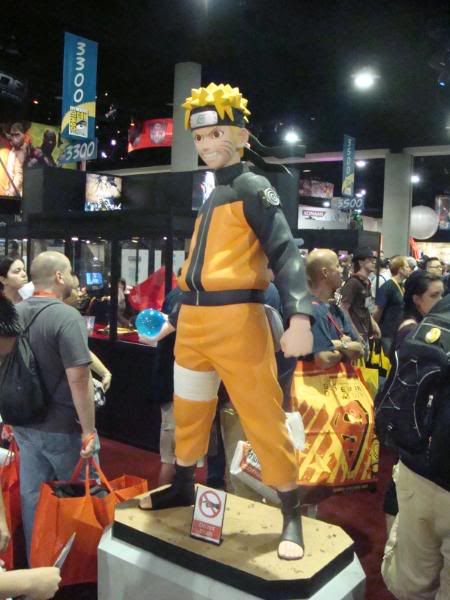
A lifesize statue of Naruto;
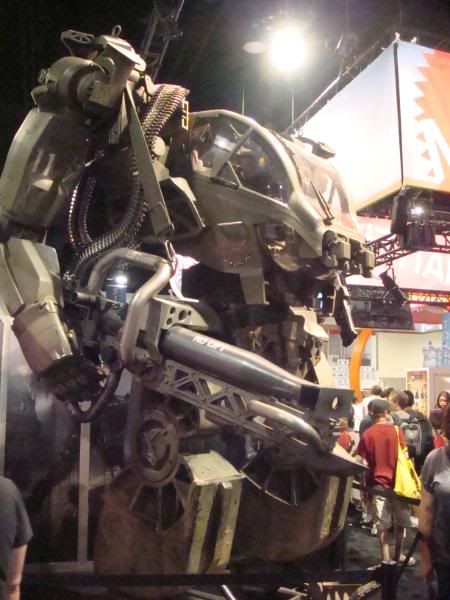
An equally lifesize battle-mech at (I believe) the Mattel booth;
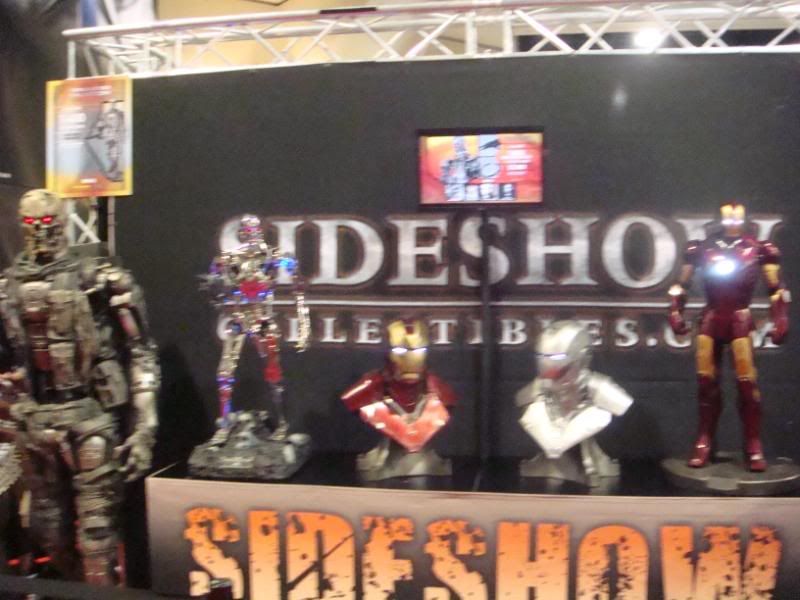

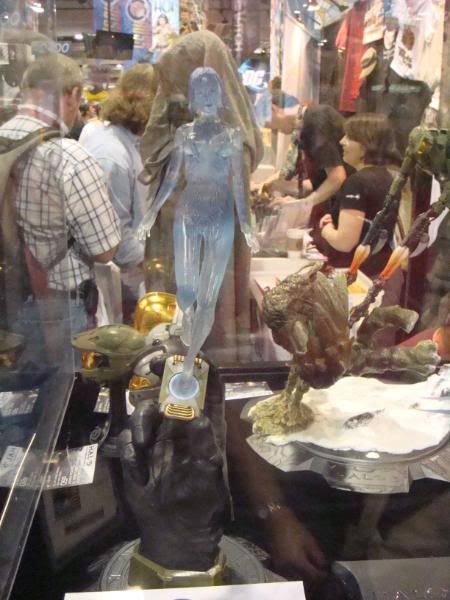
A sideshow of collectibles at the Sideshow Collectibles booth;

And this armory of steampunk rayguns from the New Zealand special effects company Weta.
We finished the evening by walking through the nearby Chuck Jones Gallery on Fifth Avenue (which had an exhibit of art by Alex Ross, Jim Lee, Dr. Seuss, and other whimsical folk); and enjoying a sundae at Ghirardelli's with our friend Janine.
On Thursday, we started hitting the panels. Our first one was a DC panel for "motion comics," comics stories and graphic novels distributed over iTunes and the Internet with voiceover narration and images computer-altered to move in a rough approximation of comic-book storytelling. What they showed wasn't that impressive (the excerpt from "Red Sun," a retelling of the Superman legend set in Russia with a cossack Batman, was especially silly). But the panel was impressive, since it included folks like writer Paul Dini, WATCHMEN artist Dave Gibbons, and DC publisher Paul Levitz.
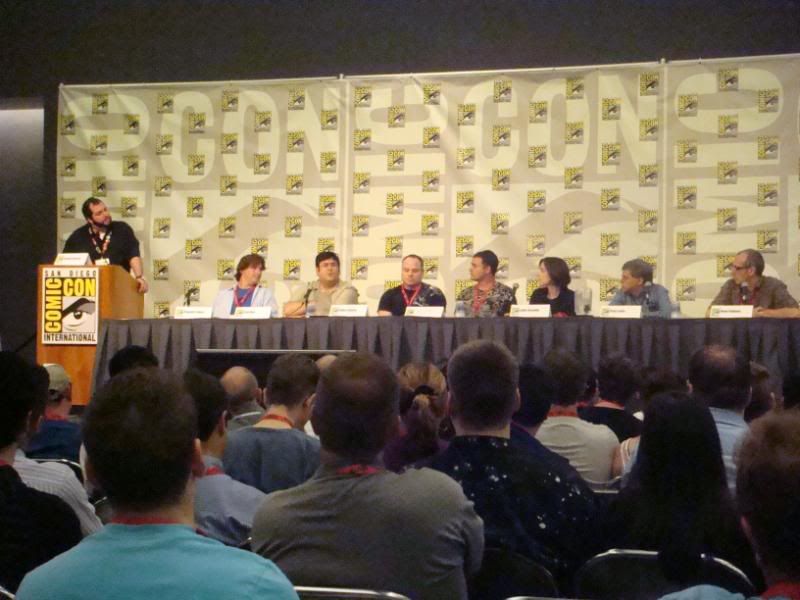

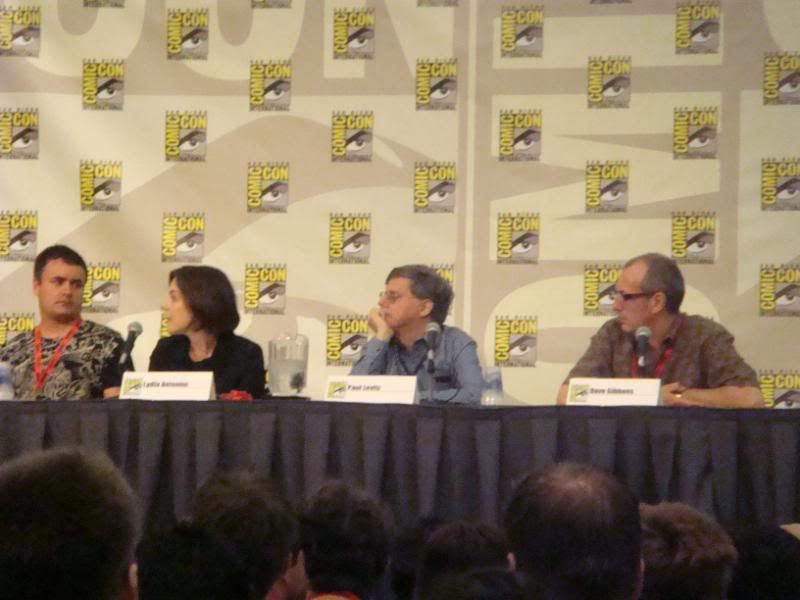
Later that day, we ventured into Room 20 (the second biggest room at the con, surpassed only by the 6,000-seat Hall H) for the Wonder Women panel put on by Entertainment Weekly. It featured a truly spectacular panel of actresses who had portrayed strong female characters in science fiction -- including STAR TREK's Zoe Saldana, LOST's Elizabeth Mitchell, DOLLHOUSE's Eliza Dushku, and most impressive of all, Sigourney Weaver. Weaver received a standing ovation. She was remarkably well-spoken for an actress working without a script; she delivered impressive speeches, and set the pace for the discussion.

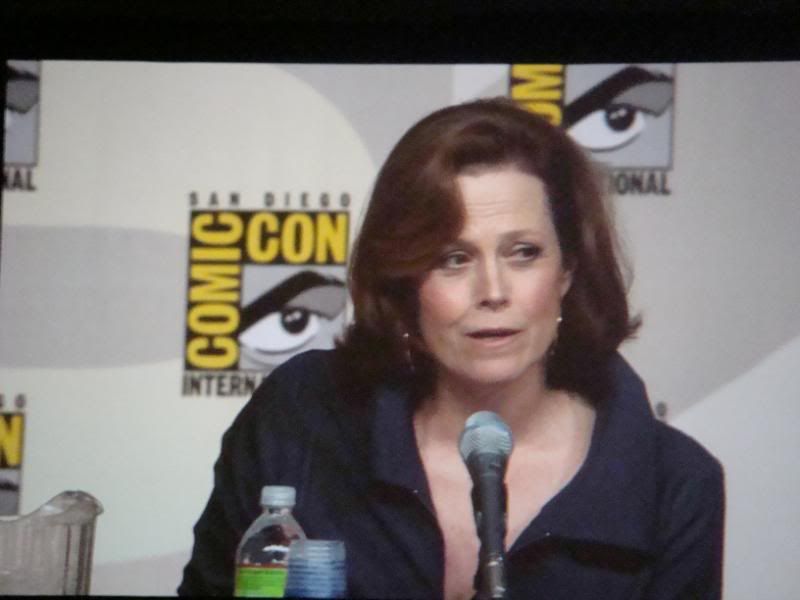
Next came the first Comic-Con panel for USA Network's hit BURN NOTICE. This panel was packed -- particularly because it featured Bruce Campbell, beloved by fans for decades of performances in genre works from EVIL DEAD through the SPIDER-MAN movies.
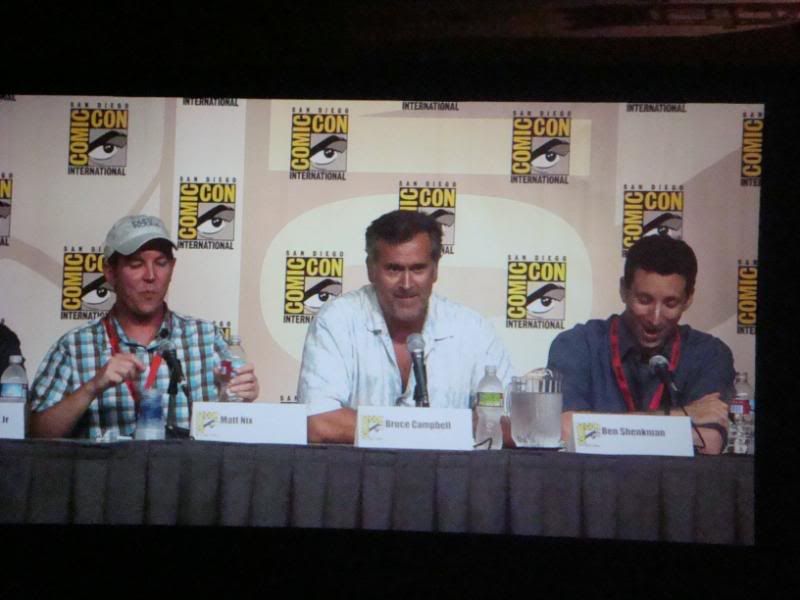
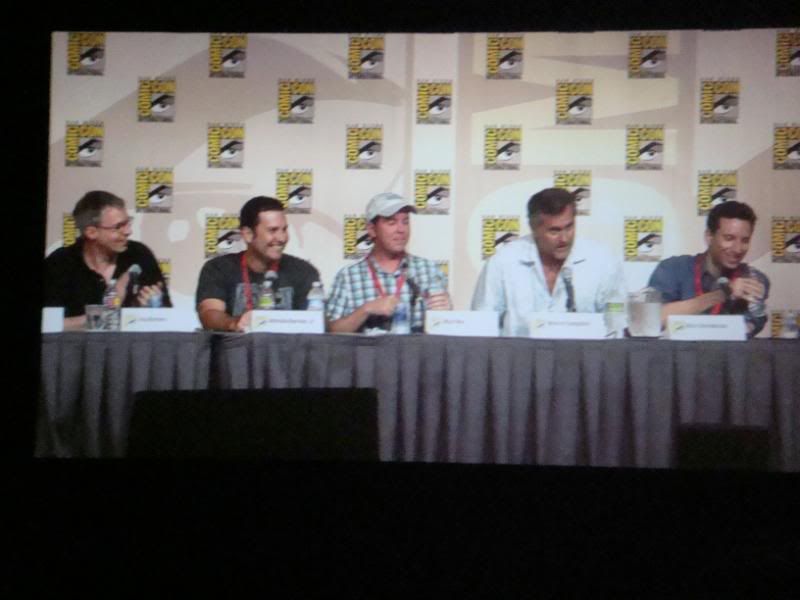

Series lead Jeffrey Donovan didn't appear on the panel; but he taped two hilarious "when you're a spy" type shorts about surviving Comic-Con, with espionage tips for attending two panels scheduled for the same time (sneak in and sabotage the A-V equipment for one of the panels, delaying it -- especially funny because the BN panel was delayed) and for getting panel giveaway swag (investigate the person in charge of giving out the swag, and blackmail him).
We then hit the first Mark Evanier-moderated panel we attended, which was his annual golden- and silver-age comics panel. This one featured such creators as '60's DC war comics artist Russ Heath, 1930's-1940's Batman artist (and creator of The Joker) Jerry Robinson, ace artist Gene Colan (whose attendance at the con was in doubt for several days before the event), Metamorpho and Aquaman artist Ramona Fradon, silver age artist and production master Murphy Anderson (who always looks quite dapper, as one might expect from a master of production), silver age artist Jack Katz, and "On Stage" comic strip creator Leonard Starr.

We had dinner at a nice Italian restaurant on Fifth Avenue with sister-in-law Helen
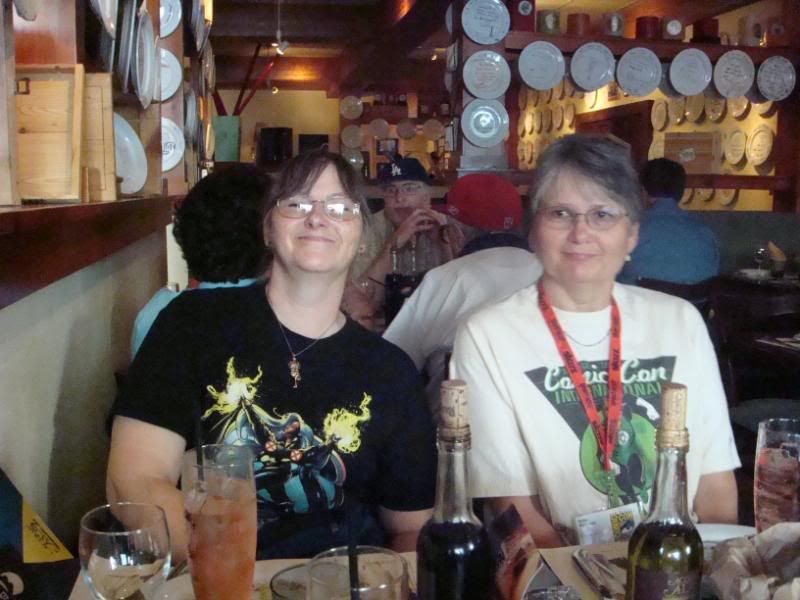
and finished the evening with a viewing of clips from recent Hong Kong kung-fu epics. (I particularly enjoyed a sequence from John Woo's movie RED CLIFFS, in which an army defeats a much vaster force by taking weapons from the hands of advancing soldiers and using them against the former wielders.)
We started Friday with a panel on one of our current favorite shows, the animated BATMAN:THE BRAVE AND THE BOLD.
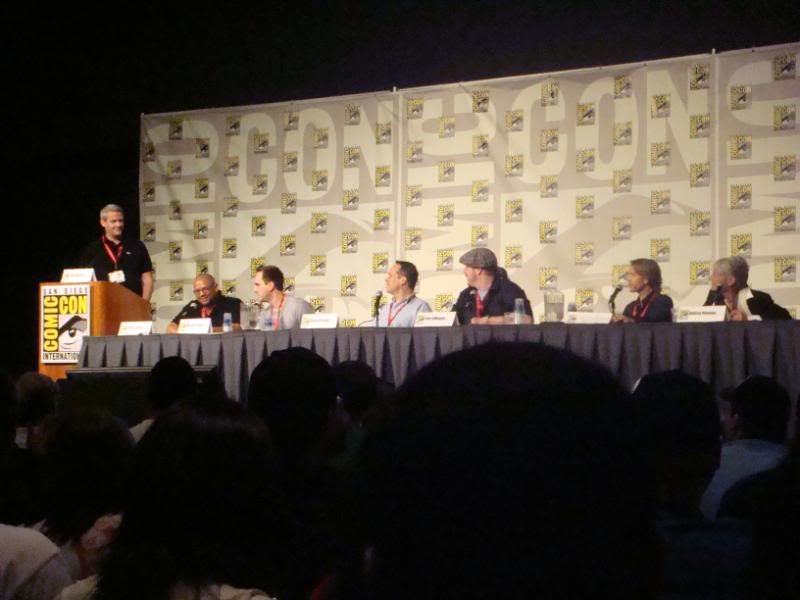
The panel included voice actors for the series, including Deidrich Bader (the voice of Batman) and John DiMaggio (the voice of the show's boisterous version of Aquaman, as well as the voice of Bender on FUTURAMA and Drakken and Motor Ed on KIM POSSIBLE).

The folks at the panel showed an episode from the coming season that featured Neil Patrick Harris as the voice of the Music Meister, a villain who controls peoples' minds by singing. The result was an almost-all-musical episode, scored in the style of several Broadway composers, that drew an enthusiastic standing O from the assembled.
In the dealer's room, the Black Beauty from the planned GREEN HORNET movie starring Seth Rogan, which was shrouded during preview night, was unveiled, revealing a sleek midnight-colored sedan bristling with weapons -- truly the "rolling arsenal" the narrator of the '60's TV show described.
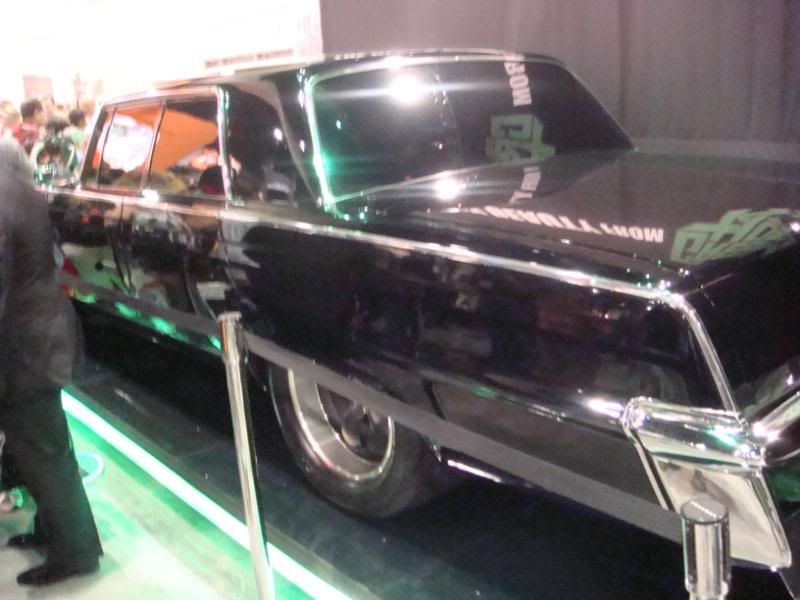

I attended another Mark Evanier panel that afternoon: his tribute to '70's comics creators, with folks like Marv Wolfman, Steve Leialoha, Doug Moench, Elliot S. Maggin, and Gene Colan again. (Due to a miscommunication, Colan had missed his own spotlight panel, which immediately preceeded this one; he entered in the middle of this panel, to thunderous applause.)
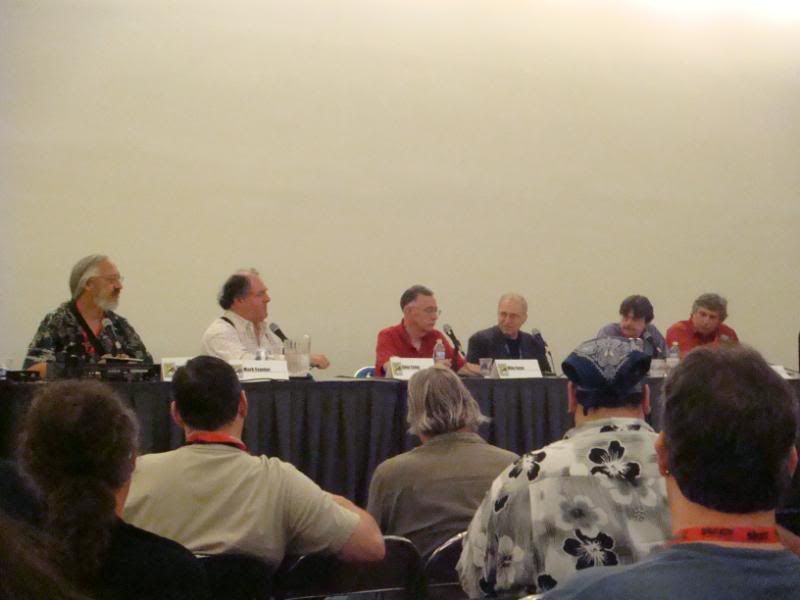
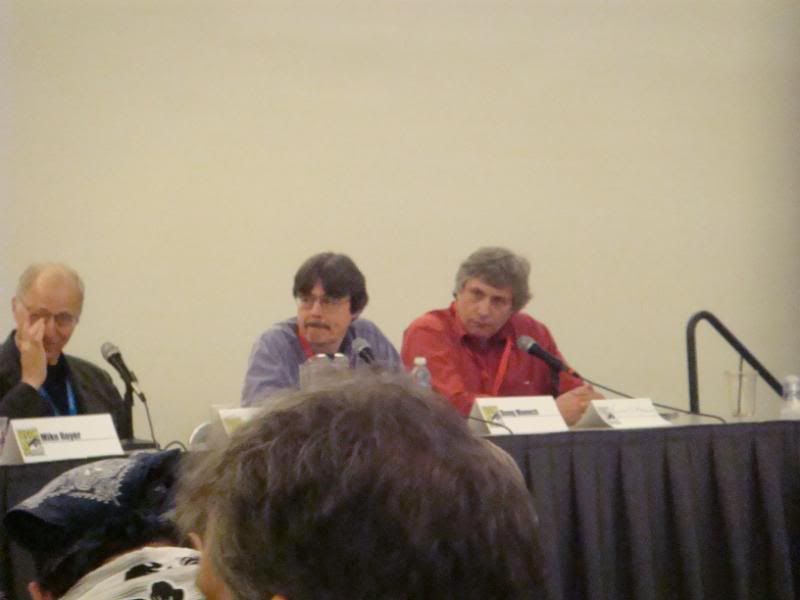
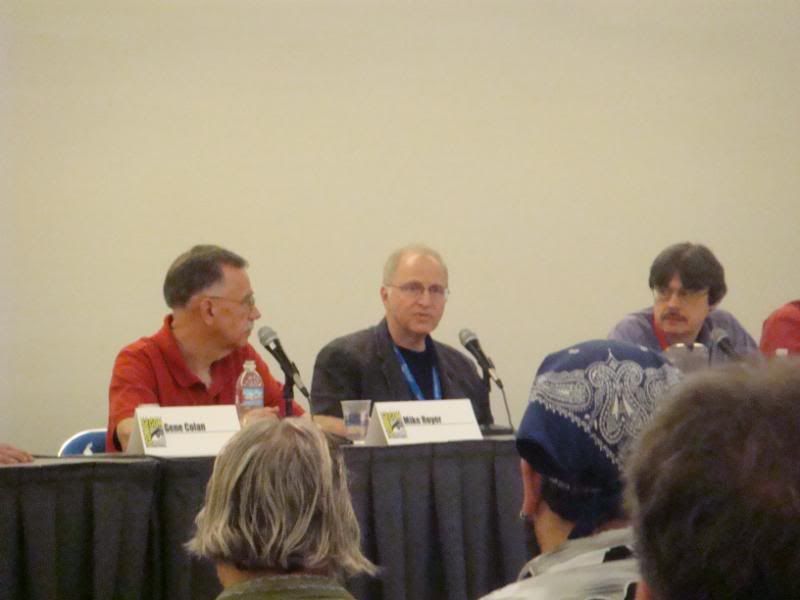
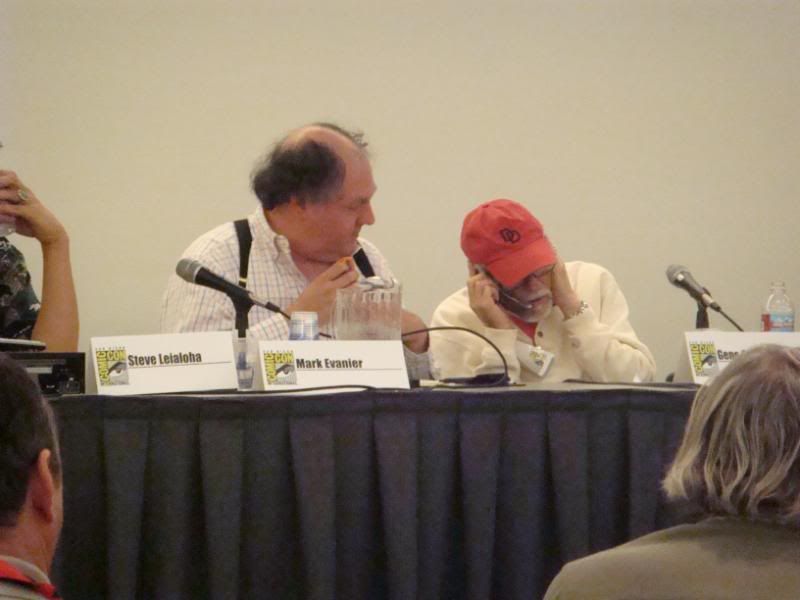
After this panel came Evanier's "Legends of Batman" panel, which featured three artists who, at various times stretching from the first Batman story to Bob Kane's last "work" on the feature in the sixties, assisted or ghosted Kane's work: Sheldon Moldoff, Jerry Robinson, and Lew Sayre Schwartz. The three played tag team as Kane's "hands": Moldoff assisted on the first Detective Comics Batman story; Robinson began assisting a few stories after that, and eventually became a ghost artist; Schwartz took over as ghost in the post-World War II period; and Moldoff ghosted from the mid-fifties through the late '60's, when "Kane" retired from comics.
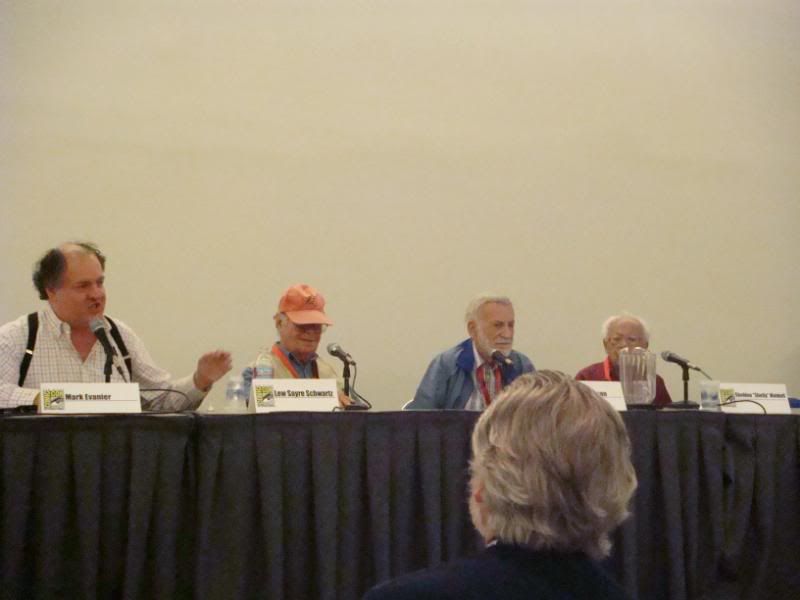
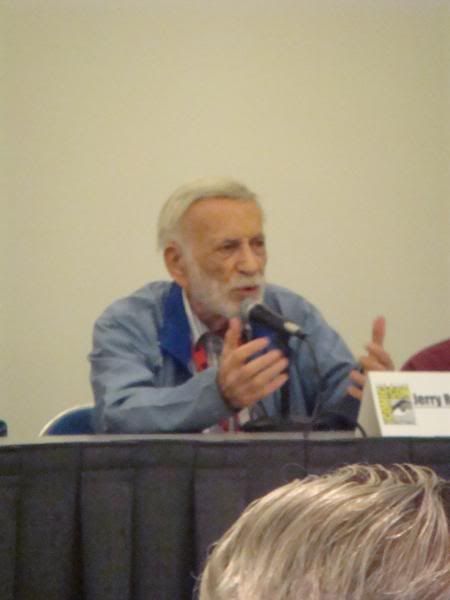
As with nearly every panel comprised of Kane's "ghosts," the subject was what a miserable (in every sense of the word) jerk Bob Kane was. Moldoff, who worked for Kane for years, didn't mince words: "He [Kane] was evil personified."
The artists offered explanations for Kane's behavior. He became rich and successful while still a teenager; and grew insecure that someone would find out the "truth" about him. So he paid artists who could draw better than he to produce the work "he" was contractually obligated to produce for DC (in addition to the Batman pages drawn by artists who worked directly for DC); and became indignant when anyone suggested he didn't draw every line and scallop of the Batman feature.
I left before the Batman panel was over, because I had to attend another panel: The International Association of Media Tie-In Writers panel, co-moderated by my cousin Lee Goldberg, and featuring Lee's brother Tod as a nominee for the organization's Scribe awards.

Because Tod writes the BURN NOTICE tie-in novels, Amy and I donned the BURN NOTICE T-shirts we had gotten at the previous day's panel and wore them to the IAMTW panel, to root Tod on.
Alas, Tod didn't win; but he, Lee, and the other IAMTW panelists (including co-founder Max Collins, who manages to write novelizations of numerous properties, original novels of numerous others, and tons of original mystery novels) put on a funny and entertaining panel.

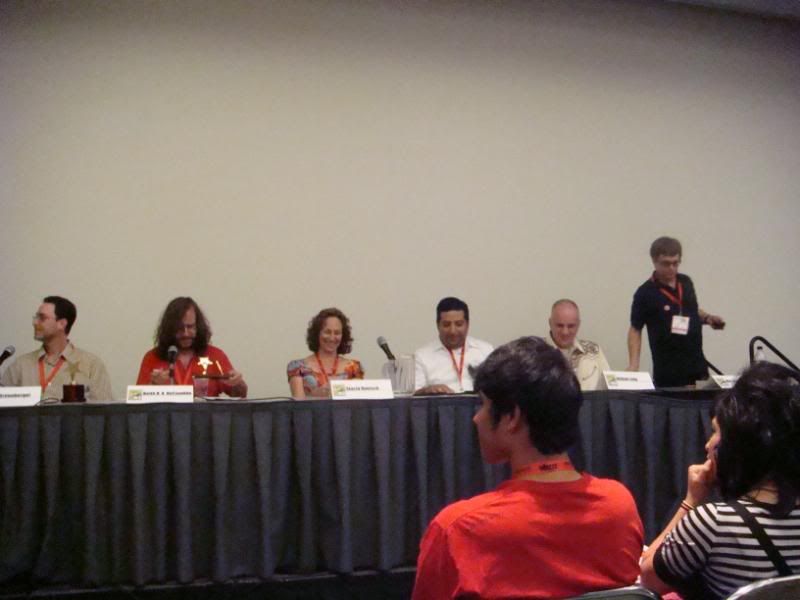
Afterward, we led the panel over to their assigned autograph area, under the "sails" on top of the convention center, where a line waited patiently to get their tie-in books signed.

Lee and Tod immediately launched into engaged conversations with their book-buying audience.

Out on the exhibit hall floor, we met up with our friends Laurid (from Colorado) and Natalie (from Utah), where we admired such marvels (er, DC's) as the Batpod cycle from the DARK KNIGHT movie.
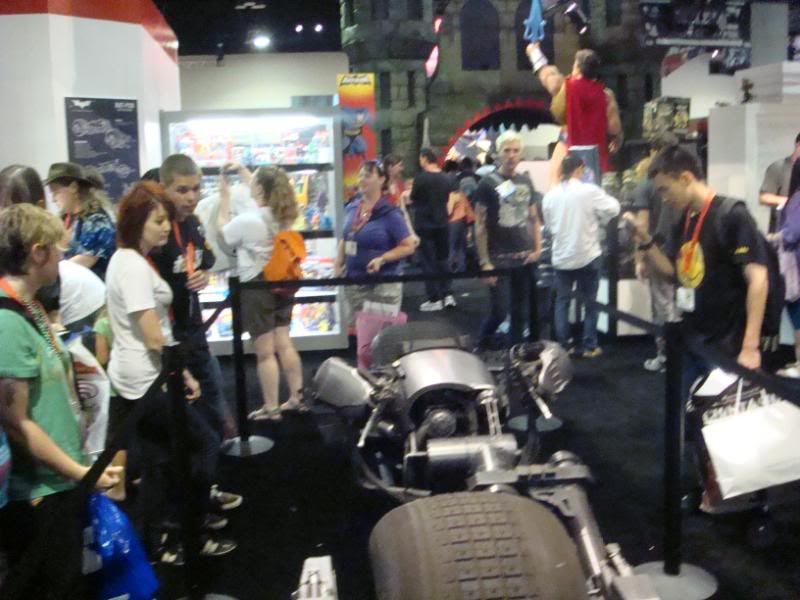
We also visited the booth of fan-favorite graphic novelist Phil Foglio, decked out in his victorian finery.
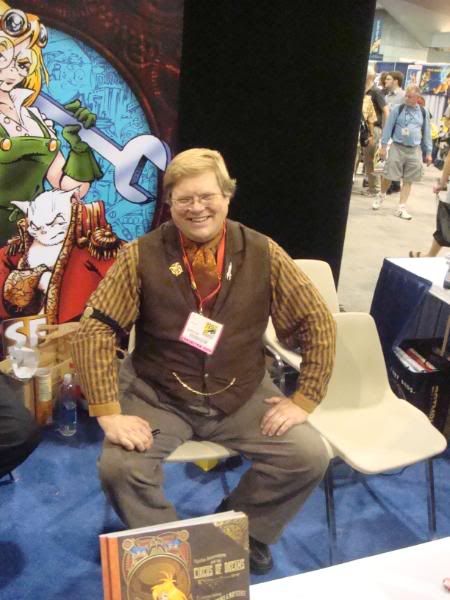
His table displayed an astounding fan-made statue of one of the tiny "clank" robots from his webcomic/graphic novel series, GIRL GENIUS:
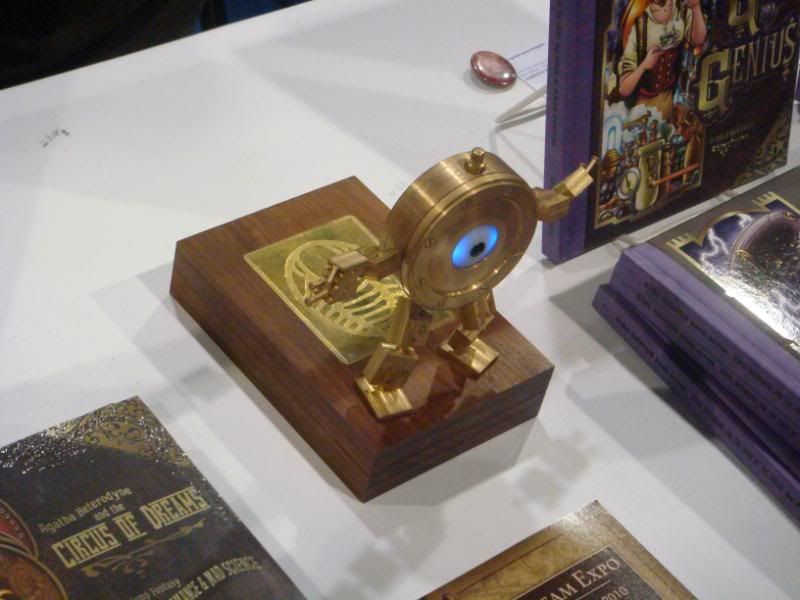
Later that night, we attended the Eisner awards at their new home, the recently-completed Bayview Hyatt hotel. There we saw such presenters as voice- and live-action actor Patton Oswald:

and everyone's favorite all-black-wearing best-selling fantasy novelist, Neil Gaiman.

On Saturday, we put on our steampunk duds, in anticipation of the steampunk meetup at mid-day. Here's a picture of us from the Steampunk Fashion Livejournal page:
 (Yeah, my goggles were askew. It happens.)
(Yeah, my goggles were askew. It happens.)
We attended a couple of panels that morning, including Mark Evanier's ever-entertaining QUICKDRAW! panel (which was held in a huge ballroom -- and easily filled it). We cut out of that early, because we had been told that the Steampunk meetup/panel would be held in one of the tiniest rooms at the convention center -- and was always mobbed. We therefore got in line an hour before the panel. So did lots of steampunky folks, which prompted lots of photos and videos from the passers by. Eventually the room opened up; and our promptness did us no good: Only 60 people were allowed into the room, and we (and most of the other 200-some people lined up) didn't make the cut.
All was not lost, however; as related in other recent posts, we took part in what was billed as the largest steampunk photoshoot to date. Afterward, we came inside to pose for individual photos.

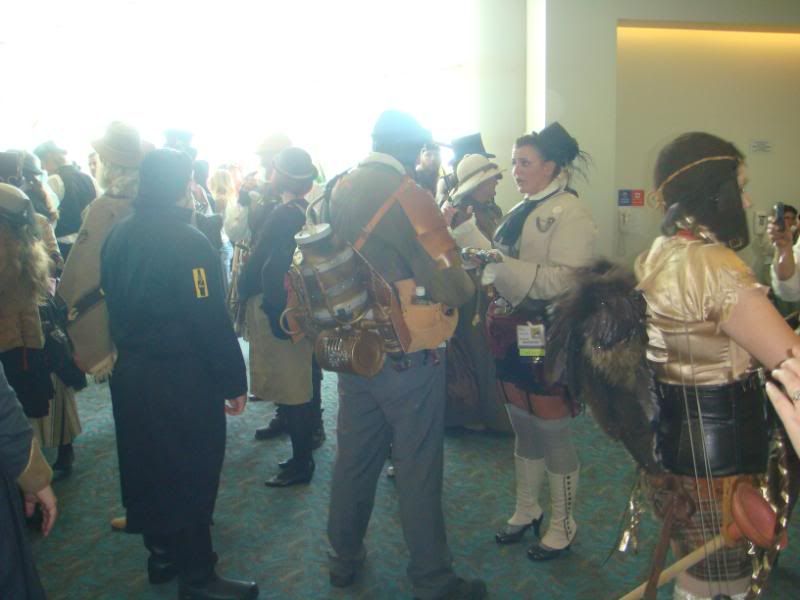

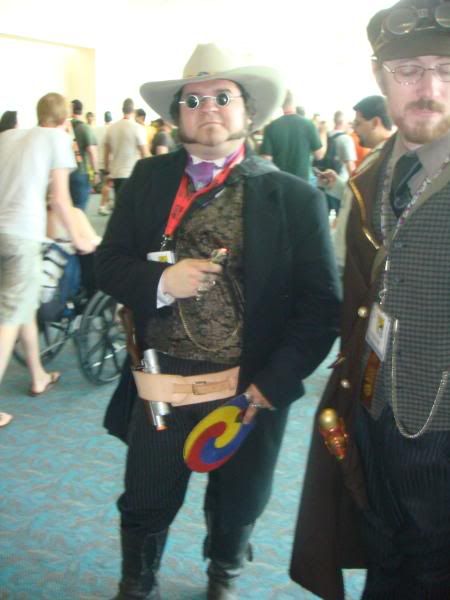
There were some terrific programs planned for Hall H that afternoon (including an IRON MAN II panel that I was eager to see); but I was disinclined to wait out in the sun in my black boots, linen pants, vest and topcoat for the slight chance of getting in.
So we walked the exhibit hall, often with Laurid and Natalie. This was the first time in the 22 Comic-Cons I've gone to where I attended in a costume. The effect is fascinating. In the standard con uniform of T-shirt and cargo shorts, I become invisible, just one of the hordes. Put on an unusual outfit, and you stand out, even among tons of people in costume. Folks come up to you, ask to take your picture, chat with you, and basically become your friend for a few seconds. The reception (at least to me) was universally positive. I can see how this can be addictive for those who bring multiple costumes to conventions.
One of the sights we came across was a wall of Iron Man armors in the Marvel booth:
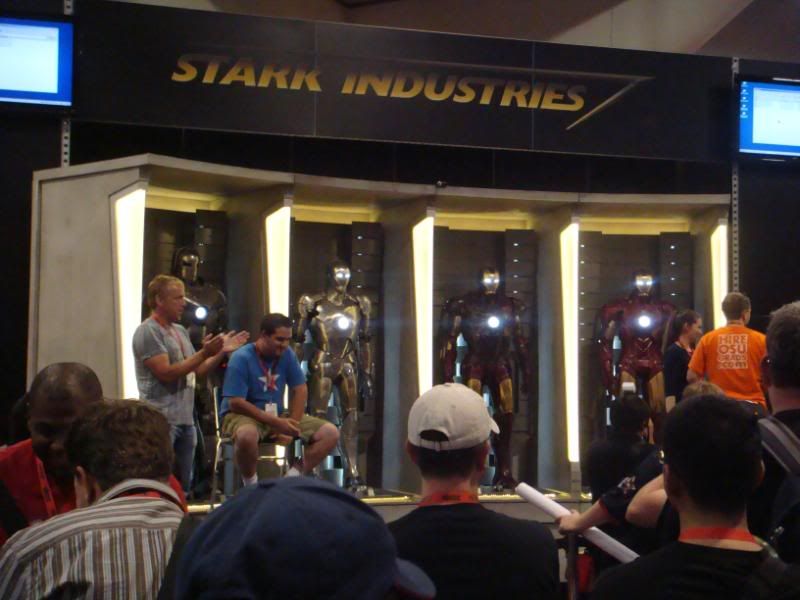
Another was one of the employees at Phil Foglio's booth, who was costumed as the character Dupree from the GIRL GENIUS comic:

Another costumed person was Laurid, who was clad in a perfect Stargate uniform.

That evening, we went to dinner with Natalie, Laurid and another Utah friend, Sarah. We walked over to The Old Spaghetti Factory, a restaurant that was a mainstay of the con for decades until the building was taken over by another restaurant. This year, the Factory returned, in the same building, with a fancy bar (which took the sting out of the long waits for dinner at the Factory), separately operated, on the second floor. The Factory was everything we remembered so fondly: great service, good food, and extremely reasonable prices.
Sunday brought (in addition to the voice actor panel covered in another post) our last crack at the exhibit hall, and our last chance to photograph hall costumes:
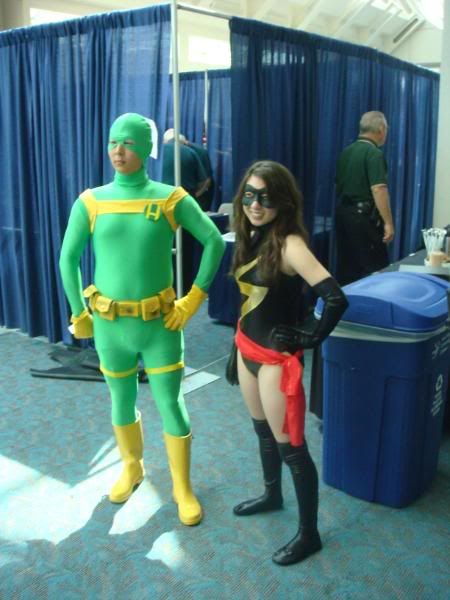
Cute:
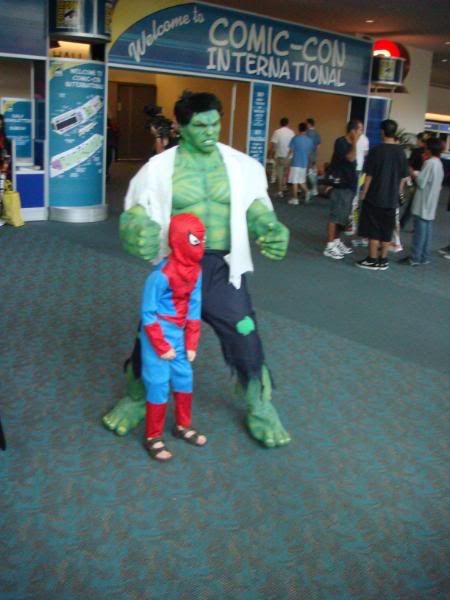
Even cuter:
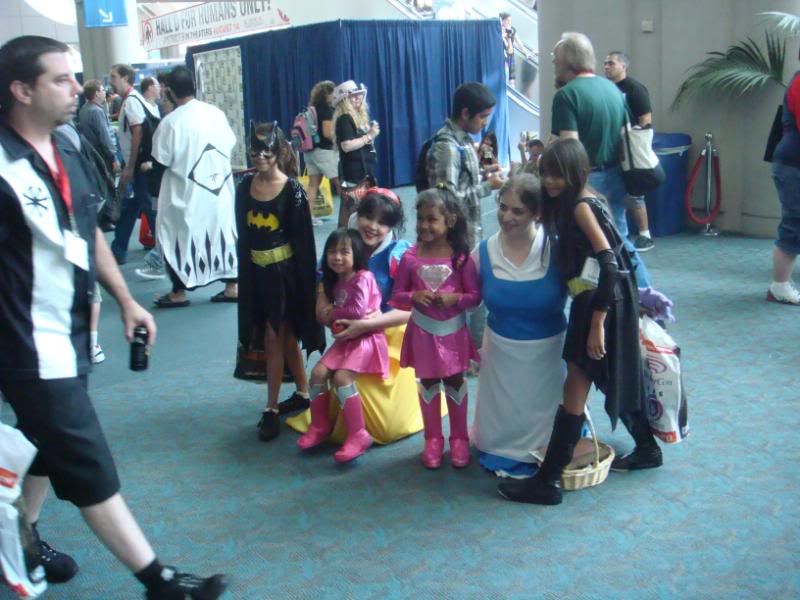
In a whirlwind tour of Artist's Alley in the last hour of the con, we chatted with former child star (not to mention Babylon 5 actor, and half of the novelty-record team Barnes & Barnes) Bill Mummy; comedy legend Stan Freburg and his wife, who were attending the con for the first time; and Gene Colan, who took the fact we were from Los Angeles as an opportunity to discuss Gary Cooper and the mystique of the movie star. A heady combination in a short time.
Finally, we had to bid the Con adieu. We had a steak dinner with Helen at the Red Fox, the restaurant that adjoined our hotel (which gave us a chance to escape the long waits for every restaurant within two miles of the convention center); and hit the road home.
No matter how big it gets, it's my favorite convention. Where else can you see and do all this?
Due to this being the 40th Comic-Con (but not the 40th anniversary -- the first two cons were held in the same year, and anyone who calls this the 40th anniversary of the con doesn't know what "anniversary" means), the souvenir program book printed the attendance for each of the preceding cons. My first -- the 1980 con -- had about 3,000 attendees. This con had 120,000 paid attendees. That's not counting (I presume) the exhibitors, and the professionals, and the security, and the con center staff, and the folks who sneaked in . . . well, the estimate I heard was 250,000 coming through the doors per day, which is a lot of humanity.
That said, let's get to what happened:
On Wednesday, preview night, we made a quick sweep of the dealer's room -- excuse me, exhibit hall (as the kids call it these days) -- which, as usual, was filled with wonders such as:

A lifesize statue of Naruto;

An equally lifesize battle-mech at (I believe) the Mattel booth;



A sideshow of collectibles at the Sideshow Collectibles booth;

And this armory of steampunk rayguns from the New Zealand special effects company Weta.
We finished the evening by walking through the nearby Chuck Jones Gallery on Fifth Avenue (which had an exhibit of art by Alex Ross, Jim Lee, Dr. Seuss, and other whimsical folk); and enjoying a sundae at Ghirardelli's with our friend Janine.
On Thursday, we started hitting the panels. Our first one was a DC panel for "motion comics," comics stories and graphic novels distributed over iTunes and the Internet with voiceover narration and images computer-altered to move in a rough approximation of comic-book storytelling. What they showed wasn't that impressive (the excerpt from "Red Sun," a retelling of the Superman legend set in Russia with a cossack Batman, was especially silly). But the panel was impressive, since it included folks like writer Paul Dini, WATCHMEN artist Dave Gibbons, and DC publisher Paul Levitz.



Later that day, we ventured into Room 20 (the second biggest room at the con, surpassed only by the 6,000-seat Hall H) for the Wonder Women panel put on by Entertainment Weekly. It featured a truly spectacular panel of actresses who had portrayed strong female characters in science fiction -- including STAR TREK's Zoe Saldana, LOST's Elizabeth Mitchell, DOLLHOUSE's Eliza Dushku, and most impressive of all, Sigourney Weaver. Weaver received a standing ovation. She was remarkably well-spoken for an actress working without a script; she delivered impressive speeches, and set the pace for the discussion.


Next came the first Comic-Con panel for USA Network's hit BURN NOTICE. This panel was packed -- particularly because it featured Bruce Campbell, beloved by fans for decades of performances in genre works from EVIL DEAD through the SPIDER-MAN movies.



Series lead Jeffrey Donovan didn't appear on the panel; but he taped two hilarious "when you're a spy" type shorts about surviving Comic-Con, with espionage tips for attending two panels scheduled for the same time (sneak in and sabotage the A-V equipment for one of the panels, delaying it -- especially funny because the BN panel was delayed) and for getting panel giveaway swag (investigate the person in charge of giving out the swag, and blackmail him).
We then hit the first Mark Evanier-moderated panel we attended, which was his annual golden- and silver-age comics panel. This one featured such creators as '60's DC war comics artist Russ Heath, 1930's-1940's Batman artist (and creator of The Joker) Jerry Robinson, ace artist Gene Colan (whose attendance at the con was in doubt for several days before the event), Metamorpho and Aquaman artist Ramona Fradon, silver age artist and production master Murphy Anderson (who always looks quite dapper, as one might expect from a master of production), silver age artist Jack Katz, and "On Stage" comic strip creator Leonard Starr.

We had dinner at a nice Italian restaurant on Fifth Avenue with sister-in-law Helen

and finished the evening with a viewing of clips from recent Hong Kong kung-fu epics. (I particularly enjoyed a sequence from John Woo's movie RED CLIFFS, in which an army defeats a much vaster force by taking weapons from the hands of advancing soldiers and using them against the former wielders.)
We started Friday with a panel on one of our current favorite shows, the animated BATMAN:THE BRAVE AND THE BOLD.

The panel included voice actors for the series, including Deidrich Bader (the voice of Batman) and John DiMaggio (the voice of the show's boisterous version of Aquaman, as well as the voice of Bender on FUTURAMA and Drakken and Motor Ed on KIM POSSIBLE).

The folks at the panel showed an episode from the coming season that featured Neil Patrick Harris as the voice of the Music Meister, a villain who controls peoples' minds by singing. The result was an almost-all-musical episode, scored in the style of several Broadway composers, that drew an enthusiastic standing O from the assembled.
In the dealer's room, the Black Beauty from the planned GREEN HORNET movie starring Seth Rogan, which was shrouded during preview night, was unveiled, revealing a sleek midnight-colored sedan bristling with weapons -- truly the "rolling arsenal" the narrator of the '60's TV show described.


I attended another Mark Evanier panel that afternoon: his tribute to '70's comics creators, with folks like Marv Wolfman, Steve Leialoha, Doug Moench, Elliot S. Maggin, and Gene Colan again. (Due to a miscommunication, Colan had missed his own spotlight panel, which immediately preceeded this one; he entered in the middle of this panel, to thunderous applause.)




After this panel came Evanier's "Legends of Batman" panel, which featured three artists who, at various times stretching from the first Batman story to Bob Kane's last "work" on the feature in the sixties, assisted or ghosted Kane's work: Sheldon Moldoff, Jerry Robinson, and Lew Sayre Schwartz. The three played tag team as Kane's "hands": Moldoff assisted on the first Detective Comics Batman story; Robinson began assisting a few stories after that, and eventually became a ghost artist; Schwartz took over as ghost in the post-World War II period; and Moldoff ghosted from the mid-fifties through the late '60's, when "Kane" retired from comics.


As with nearly every panel comprised of Kane's "ghosts," the subject was what a miserable (in every sense of the word) jerk Bob Kane was. Moldoff, who worked for Kane for years, didn't mince words: "He [Kane] was evil personified."
The artists offered explanations for Kane's behavior. He became rich and successful while still a teenager; and grew insecure that someone would find out the "truth" about him. So he paid artists who could draw better than he to produce the work "he" was contractually obligated to produce for DC (in addition to the Batman pages drawn by artists who worked directly for DC); and became indignant when anyone suggested he didn't draw every line and scallop of the Batman feature.
I left before the Batman panel was over, because I had to attend another panel: The International Association of Media Tie-In Writers panel, co-moderated by my cousin Lee Goldberg, and featuring Lee's brother Tod as a nominee for the organization's Scribe awards.

Because Tod writes the BURN NOTICE tie-in novels, Amy and I donned the BURN NOTICE T-shirts we had gotten at the previous day's panel and wore them to the IAMTW panel, to root Tod on.
Alas, Tod didn't win; but he, Lee, and the other IAMTW panelists (including co-founder Max Collins, who manages to write novelizations of numerous properties, original novels of numerous others, and tons of original mystery novels) put on a funny and entertaining panel.


Afterward, we led the panel over to their assigned autograph area, under the "sails" on top of the convention center, where a line waited patiently to get their tie-in books signed.

Lee and Tod immediately launched into engaged conversations with their book-buying audience.

Out on the exhibit hall floor, we met up with our friends Laurid (from Colorado) and Natalie (from Utah), where we admired such marvels (er, DC's) as the Batpod cycle from the DARK KNIGHT movie.

We also visited the booth of fan-favorite graphic novelist Phil Foglio, decked out in his victorian finery.

His table displayed an astounding fan-made statue of one of the tiny "clank" robots from his webcomic/graphic novel series, GIRL GENIUS:

Later that night, we attended the Eisner awards at their new home, the recently-completed Bayview Hyatt hotel. There we saw such presenters as voice- and live-action actor Patton Oswald:

and everyone's favorite all-black-wearing best-selling fantasy novelist, Neil Gaiman.

On Saturday, we put on our steampunk duds, in anticipation of the steampunk meetup at mid-day. Here's a picture of us from the Steampunk Fashion Livejournal page:
 (Yeah, my goggles were askew. It happens.)
(Yeah, my goggles were askew. It happens.)We attended a couple of panels that morning, including Mark Evanier's ever-entertaining QUICKDRAW! panel (which was held in a huge ballroom -- and easily filled it). We cut out of that early, because we had been told that the Steampunk meetup/panel would be held in one of the tiniest rooms at the convention center -- and was always mobbed. We therefore got in line an hour before the panel. So did lots of steampunky folks, which prompted lots of photos and videos from the passers by. Eventually the room opened up; and our promptness did us no good: Only 60 people were allowed into the room, and we (and most of the other 200-some people lined up) didn't make the cut.
All was not lost, however; as related in other recent posts, we took part in what was billed as the largest steampunk photoshoot to date. Afterward, we came inside to pose for individual photos.




There were some terrific programs planned for Hall H that afternoon (including an IRON MAN II panel that I was eager to see); but I was disinclined to wait out in the sun in my black boots, linen pants, vest and topcoat for the slight chance of getting in.
So we walked the exhibit hall, often with Laurid and Natalie. This was the first time in the 22 Comic-Cons I've gone to where I attended in a costume. The effect is fascinating. In the standard con uniform of T-shirt and cargo shorts, I become invisible, just one of the hordes. Put on an unusual outfit, and you stand out, even among tons of people in costume. Folks come up to you, ask to take your picture, chat with you, and basically become your friend for a few seconds. The reception (at least to me) was universally positive. I can see how this can be addictive for those who bring multiple costumes to conventions.
One of the sights we came across was a wall of Iron Man armors in the Marvel booth:

Another was one of the employees at Phil Foglio's booth, who was costumed as the character Dupree from the GIRL GENIUS comic:

Another costumed person was Laurid, who was clad in a perfect Stargate uniform.

That evening, we went to dinner with Natalie, Laurid and another Utah friend, Sarah. We walked over to The Old Spaghetti Factory, a restaurant that was a mainstay of the con for decades until the building was taken over by another restaurant. This year, the Factory returned, in the same building, with a fancy bar (which took the sting out of the long waits for dinner at the Factory), separately operated, on the second floor. The Factory was everything we remembered so fondly: great service, good food, and extremely reasonable prices.
Sunday brought (in addition to the voice actor panel covered in another post) our last crack at the exhibit hall, and our last chance to photograph hall costumes:

Cute:

Even cuter:

In a whirlwind tour of Artist's Alley in the last hour of the con, we chatted with former child star (not to mention Babylon 5 actor, and half of the novelty-record team Barnes & Barnes) Bill Mummy; comedy legend Stan Freburg and his wife, who were attending the con for the first time; and Gene Colan, who took the fact we were from Los Angeles as an opportunity to discuss Gary Cooper and the mystique of the movie star. A heady combination in a short time.
Finally, we had to bid the Con adieu. We had a steak dinner with Helen at the Red Fox, the restaurant that adjoined our hotel (which gave us a chance to escape the long waits for every restaurant within two miles of the convention center); and hit the road home.
No matter how big it gets, it's my favorite convention. Where else can you see and do all this?
Subscribe to:
Comments (Atom)
